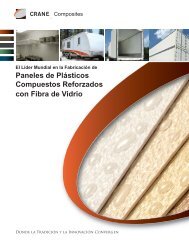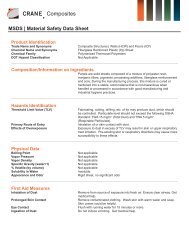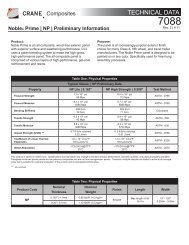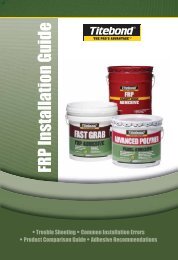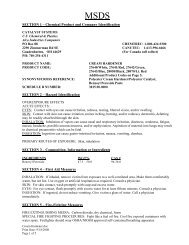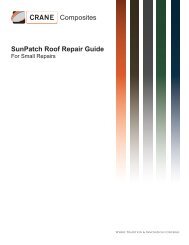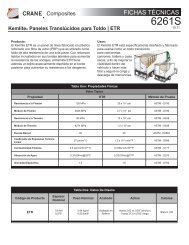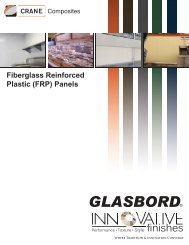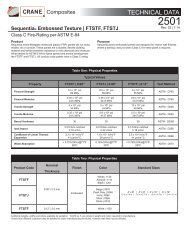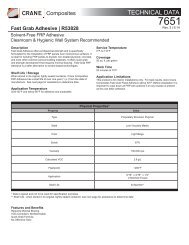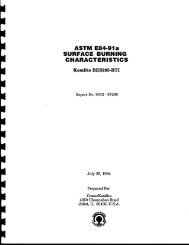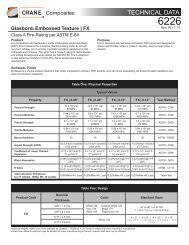Chemical and Stain Resistance Testing - Crane Composites
Chemical and Stain Resistance Testing - Crane Composites
Chemical and Stain Resistance Testing - Crane Composites
Create successful ePaper yourself
Turn your PDF publications into a flip-book with our unique Google optimized e-Paper software.
<strong>Chemical</strong> <strong>and</strong> <strong>Stain</strong> <strong>Resistance</strong> <strong>Testing</strong>General <strong>Chemical</strong> <strong>Resistance</strong>ProductsDilute Acids(less than 30%)Concentrated Acids(30% or more)Weak AlkalisStrong AlkalisChlorinated SolventsAldehydes & KetonesEstersGlasbord ProductsG to E G to E G E G to ESequentia ProductsKey | E=excellent, G=good, F=fair (test before using), P=poor, not recommended<strong>Resistance</strong> to Specific <strong>Chemical</strong>sGENERAL NOTES• Ratings are based on a combination of visual observations, <strong>and</strong> mechanical strength test results.• All testing was done at 77°F +/- 10°F. Performance ratings are not necessarily valid outside of that temperature range.• Test ratings are based on white material; non-white panels could show additional visual changes.• Test was run per <strong>Crane</strong> <strong>Composites</strong> product development procedure #8125: surface chemical resistance. In this procedure the chemicals areexposed to the surface of the panel for 7 days.RATING KEY• E (Excellent): Suitable for use in most exposure conditions.• G (Good): Probably suitable for use; testing under specific exposure conditions is suggested.• F (Fair): Possibly unsuitable for use; testing under specific exposure conditions is recommended.• P (Poor): Unsuitable for use in most exposure conditions.• C: Color change• NT: Not tested<strong>Chemical</strong>GlasbordPanelsSequentiaPanelsSanigrid CeilingGrid SystemGeneral CommentsAcetic Acid, concentrated E P E Caused Sequentia panels to turn yellow <strong>and</strong> erodeAcetic Acid, 5% E E EAmmonium Hydroxide, concentrated E C C Caused Sequentia <strong>and</strong> Sanigrid to turn yellowAmmonium Hydroxide, 10% C C C Caused all to turn yellowAniline P 1 P C Caused all to turn yellowBleach Solution C C E Caused panels to turn yellowCitric Acid, 10% E E C Caused Sanigrid to turn yellowDetergent Solution C E E Caused panels to turn yellowDistilled Water E E EEthyl Acetate P 1 P EEthyl Alcohol, 95% C G NT Caused panels to turn yellowEthyl Alcohol, 50% G 1 E NT Caused Sequentia panels slight reduction in strengthFormaldehyde E E EHeptane F G E Caused Sequentia panels slight reduction in strengthHydrochloric Acid, 10% E E EHydrogen Peroxide, 3% C E E Caused panels to turn yellowIsoctane G 1 G E Caused Sequentia panels slight reduction in strengthLactic Acid, 10% E E EMineral Oil E E G Sanigrid absorbed some oilNitric Acid, 40% E G C Sanigrid turned slight yellow/blueNitric Acid, 10% C E CSanigrid turned slight yellow/blueCaused Sequentia panels slight reduction in strength
<strong>Chemical</strong>GlasbordPanelsSequentiaPanelsSanigrid CeilingGrid SystemGeneral CommentsOleic Acid G 1 E G Sanigrid absorbed some oilOlive Oil E E Sanigrid absorbed some oilPotassium Iodide Solution, 10% E C G Sanigrid II turned red | Sequentia turned yellowSoap Solution E E CSodium Chloride Solution, 10% P 1 E E Caused panels to turn yellowSodium Chloride Solution, 60% P G E Caused Sequentia panels slight reduction in strengthSodium Hydroxide Solution, 10% P NT E Caused panels to turn yellowSodium Hydroxide Solution, 1% P NT E Caused panels to turn yellowSodium Hydroxide Solution, 4-6% E NT ESulfuric Acid, 30% G 1 G NT Caused Sequentia panels slight reduction in strengthSulfuric Acid, 3% G 1 E EToluene G 1 P E Caused panels to turn yellowTransformer Oil G 1 NT NT Sanigrid absorbed some oilTurpentine G 1 E G<strong>Stain</strong> <strong>Resistance</strong> to Food <strong>and</strong> Miscellaneous ProductsKEY• Unaffected = wipes off easily with damp cloth <strong>and</strong> mild soap; no color or surface change• Superficial = stain removes easily with water <strong>and</strong>/or mild abrasive• Considerable = stain not completely removedTESTING INFORMATION1. ASTM D2299 | test stain resistance of applied coating2. ASTM D1308 | test stain resistance of a product’s natural surface<strong>Stain</strong>ASTM D2299 (Test #1) ASTM D2299 (Test #2)Glasbord Panels Glasbord Panels Sequentia PanelsBlood (beef) Superficial Superficial SuperficialBrown Show Polish Considerable Considerable ConsiderableButter Unaffected Unaffected UnaffectedCrayon Superficial Superficial SuperficialMustard Unaffected Superficial SuperficialOil (crankcase) Superficial Superficial SuperficialPotatoes (white) Unaffected Unaffected UnaffectedRed Cabbage Unaffected Unaffected UnaffectedTea Unaffected Unaffected UnaffectedTomato Acid Unaffected Unaffected Unaffectedwww.FRP.com | 1.800.435.0080 | 1.815.467.8666 (fax) | salesbp@cranecomposites.com<strong>Crane</strong> <strong>Composites</strong> is the manufacturer of Glasbord, Sequentia, Sanigrid II <strong>and</strong> a variety of other fiberglass reinforced plastic (FRP) composite wall panels.Inspired by the Kemlite tradition, <strong>Crane</strong> <strong>Composites</strong> has over 55 years of experience in Commercial Building Products <strong>and</strong> is a recognized industry leaderin FRP applications.We believe all information given is accurate. It is offered in good faith, but without guarantee. Since conditions of use are beyond our control, all risks are assumed by the user. Nothing herein shallbe construed as a recommendation for uses which infringe on valid patents or as extending a license under valid patents.Form 6230 | Rev. 9 | 2.11 | (5725)



